 |
|

|
 |
TABLE of CONTENTS
 |
2014 legislative session was "largely successful" for MnDOT |
By Shalini Chandra, Government Affairs
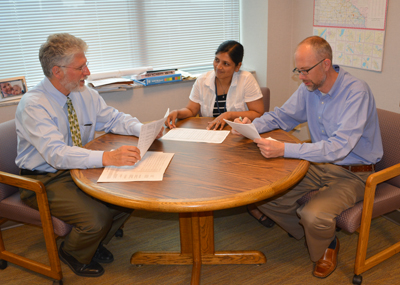
From left, Scott Peterson, Government Affairs director; Shalini Chandra, legislative assistant on mobility from the Bridge Office, and Erik Rudeen, state legislative liaison; discuss transportation bills that were passed by the Legislature during the 2014 session. Photo by Rich Kemp |
Minnesota’s unprecedented legislative session came to a close on Friday, May 16. It started with the Unsession, an attempt to encourage state agencies and legislators to eliminate unnecessary or redundant laws, rules and regulations to make state government more efficient. Despite the late start in February, the session adjourned earlier than scheduled with significant accomplishments achieved during the short months.
Transportation was a focus at the Capitol this session with the crumbling state of infrastructure brought to light by the severe winter. Legislation that proposed a gross receipts motor fuel tax didn’t move up through the committee process, but re-fueled discussion about the need for sustainable funding. Transportation safety drove legislative efforts and bills were passed to enhance workzone and railroad safety.
While no long-term transportation funding solution was enacted, some transportation needs were addressed through the capital investment bills, which came in two pieces: an $846 million bonding bill, with $57 million dedicated to transportation, and a $200 million cash bill, with $52 million dedicated to transportation.
“This session was largely successful for MnDOT,” said Commissioner Charlie Zelle. “We look forward to continuing the discussion about transportation funding needs and experiencing a more successful session next year.”
The final capital investment bills include:
- $54 million for local roads
- $33 million for local bridges
- $5 million for the Range Regional Airport
- $4.4 million for the Willmar headquarters reconstruction
- $3.6 million for the Little Falls truck station
- $2.2 million for the International Falls Airport
- $2 million for railroad grade crossings
- $2 million for port development assistance
- $1.5 million for greater Minnesota transit
- $1 million for Safe Routes to School
In addition, the Legislature used a portion of the surplus for a supplemental budget bill. Total funds appropriated for transportation for the biennium are approximately $136 million. Some of the appropriations include:
- $31.5 million for Corridors of Commerce
- $30 million for winter maintenance costs
- $6.5 million for Greater Minnesota transit
- $3 million for program planning and delivery
- $2 million for railroad grade crossings
- $625,000 for work zone safety initiatives
As part of the Unsession, MnDOT proposed to eliminate and modernize redundant and obsolete provisions. Language also was enacted for efficient and cost effective projects, such as removal of the length limit for certain highway projects between states, and allowing a one-week bid advertisement period for some trunk highway contracts.
Along with the two Unsession bills, MnDOT also proposed a housekeeping bill that proposed technical changes, provided bridge inspection authority and modified u-turn rules for large vehicles, among other things. A bridge on Hwy 60 is named the Michael Duane Clickner Memorial Bridge, a general purpose lane is required for I-494 between Hwy 55 to I-94, and farm vehicle language is modified to comply with the federal MAP-21 law.
Throughout the session, MnDOT emphasized efficiencies in construction projects including $50 million in savings that was detailed in a previous Newsline article and mentioned in the Governor’s State of the State address.
|
 |
|

|
 |
TABLE of CONTENTS
 |
Executive Team reestablishes agency manager rotation program |
A group of MnDOT managers will participate in a new iteration of the agency’s Manager Rotation Program beginning in June, according to Sue Mulvihill, deputy commissioner and chief engineer.
Mulvihill and Tracy Hatch, deputy commissioner, chief financial officer and chief operating officer, announced the program to employees May 28 via email.
First introduced in 2004, the rotation program provides established MnDOT managers with the opportunity to broaden their knowledge of the agency by working in an area they might not otherwise have a chance to experience, Mulvihill said.
“The program benefits both MnDOT and individual managers by helping prepare participants to compete for higher levels of responsibilities, if interested,” she said, noting that the program is part of MnDOT’s ongoing strategic staffing efforts to address anticipated workforce changes that include the retirement of experienced senior managers during the next several years.
Managers participating in the first round of the rotation program are:
- Bev Farraher, Metro District, who will take on the role of bridge construction and maintenance engineer in the Bridge Office
- John Griffith, Metro District, who will serve as the maintenance engineer for District 3
- Maureen Jensen, Materials & Road Research, who will become the assistant office director for Freight and Commercial Vehicle Operations
- Steve Lund, Maintenance, who will serve as the pavement engineer in Materials & Road Research
- Tom O’Keefe, Metro District, who will become state maintenance engineer and Office of Maintenance director
- Brad Skow, Metro District, who will be the pre-letting engineer in Project Management & Technical Support
- Tom Styrbicki, Bridge, who will serve as the Program Delivery Office director in Metro District
- Val Svensson, Project Management & Technical Support, who will be the design support engineer in Project Management & Technical Support
- Curt Turgeon, will assume the responsibilities of maintenance engineer in Metro District
- Nancy Yoo, Project Management & Technical Support, will oversee Program Delivery Efficiency Measures (a new position) for District Operations in Central Office
“Having participated in a couple of manager rotations myself (Labor Relations director and Human Resources director), I can vouch for how valuable these experiences can be,” said Mulvihill. “You can 'try on' a job for a while, get the experience and build new relationships while learning more about yourself and the organization.
“Of course, it is not always easy to leave your current position behind, but the opportunity is not something a person should pass up,” she said. “I highly recommend that folks consider rotations, mobility assignments and job exchanges whenever they can.”
The rotation assignments are expected to last between six months and a year, with participants, supervisors, senior leadership and Human Resource staff evaluating the program throughout its duration.
Hatch said that if the program goes as well as anticipated, other employees will be given similar opportunities in the future.
“MnDOT is a respected organization, made strong by the people who manage the day-to-day activities that help us provide a safe and reliable transportation system for all Minnesotans. Broadening the program participants’ knowledge of MnDOT will help the agency become even stronger and, ultimately, more efficient in accomplishing our mission,” she said. |
 |
|

|
 |
TABLE of CONTENTS
 |
MnDOT uses old-fashioned methods to reach Amish about road construction |
|
By Mike Dougherty, District 6 public affairs coordinator
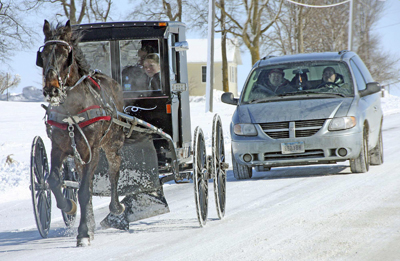
An Amish buggy moves along Hwy 52 near the Iowa border. The stretch of highway is also known as the Amish Buggy Byway. Photo courtesy of the Agri News |
Fillmore County in southeastern Minnesota is home to the state’s two largest Amish communities, which also use the Amish Buggy Byway – a stretch along Hwy 52 near the Iowa border – to travel for trade, worship and shopping.
When a traditional mill and overlay project was scheduled for a 10-mile stretch of Hwy 52 near Harmony, MnDOT had to find an alternative way to communicate with one of the groups that use the road. The Amish don’t use modern communications technology, but Dave Redig, east District 6 maintenance supervisor, and Brian Wolfgram, the Stewartville sub-area supervisor, had the solution: connect with the Amish via tour guides who visit their farms in Fillmore County.
MnDOT resorted to old-fashioned methods of word of mouth and connecting where people gather. In a letter that was distributed to Amish farms and markets where they sell Amish goods, the contractor on the project, Mathy Construction of Onalaska, Wis., outlined the project, timelines and anticipated disruptions. Tour guides, who have an established relationship with the farmers, distributed the letters.
“People who use the roadways can make better plans when we’re able to reach them with the information,” said Jeff Bunch, construction project manager. “It’s safer for everyone.”
The Minnesota Legislature marked Hwy 52, from its intersection with Hwy 44 near Prosper to its intersection with Hwy 16 east of Preston, as the Amish Buggy Byway. The green signs show a buggy and include the words Amish Byway. The byway signs have been in place since 1996. The shoulders are wider and thicker than traditional highway shoulders so the surface can withstand the regular traffic of horse-drawn buggies.
The $3.2 million project began at the Iowa border and is progressing toward Harmony approximately 2.5 to 3 miles per day. The milling and paving work is expected to be completed by the end of June. |
 |
|

|
 |
TABLE of CONTENTS
 |
Projects help congestion on Twin Cities freeways hold steady as population increases |
By Nick Carpenter, Metro District public affairs coordinator
Congestion on freeways in the Twin Cities area is holding steady even as the population of the seven-county metro area continues to increase.
The 2013 Metropolitan Freeway System Congestion Report shows the percentage of congested freeways decreased 1.5 percent last year.
Twin Cities congestion rates and estimated population
- 2013—19.9 percent congested; population at 2.95 million
- 2012—21.4 percent; 2.91 million
- 2011—21 percent; 2.87 million
- 2010—21.5 percent; 2.85 million
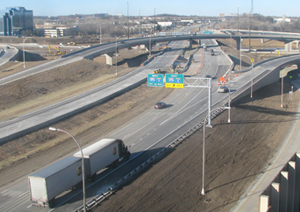
The Hwy 169/Interstate 494 interchange project used design techniques to reduce congestion, while saving approximately $30 million to $40 million in construction costs. Photo by David Gonzalez |
“In addition to providing a safe and modern transportation system, one of our primary goals is to make sure the system is reliable and efficient,” said Commissioner Charlie Zelle. “By reducing congestion and increasing the reliability of our transportation system, we all will experience shorter travel times and cost savings through reduced fuel use.”
MnDOT completed several projects in 2012 aimed at improving traffic flow in the Twin Cities, including:
- Hwy 169/Interstate 494 interchange in the Bloomington, Edina and Eden Prairie—MnDOT used a performance-based design to rebuild the interchange with six ramps instead of the traditional eight. Crews also connected the north and south frontage roads under Hwy 169 and removed traffic signals to reduce congestion. These improvements addressed more than 90 percent of motorists’ needs while saving approximately $30 million to $40 million in construction costs.
- I-94 Smart Lanes—Crews installed Smart Lane technology to provide real-time travel alerts to I-94 motorists traveling between Minneapolis and St. Paul. The electronic signs display notices about crashes, merges, closed lanes and other advisories to help manage traffic.
- I-694/Hwy 10/I-35W in Arden Hills and Mounds View—MnDOT completed a portion of the multi-year I-694 North Central project. Work included construction of two new bridges to carry Hwy 10 and Ramsey County Road 10 traffic over I-35W. Crews also widened the Lexington Avenue Bridge over I-694. The bridge features new left turn lanes, an improved signal system, and widened ramps to and from the freeway to improve traffic flow.
“These projects provide a sampling of several strategies we have in place to manage congestion and address growing travel demand,” Zelle said.
Congestion management strategies
- Active Traffic Management—an advanced system of cameras, traffic sensors, ramp meters, overhead electronic message signs, Smart Lanes, and real-time travel information including www.511mn.org and www.mndot.gov. MnDOT also operates a Freeway Incident Response Safety Team that minimizes congestion and prevents secondary crashes through the rapid response and removal of incidents.
- Strategic capacity enhancements—additional capacity improvements in certain locations including added traffic lanes, bus-only shoulders, dynamic shoulder lanes or interchange capacity improvements.
- Low-cost, high-return improvements—projects that improve flow by relieving bottlenecks on freeways and arterials, improving geometric design and addressing safety hazards. Some of these improvements enhance capacity by adding short auxiliary lanes and others focus on system management. In some cases, flexible design principles are used to optimize the use of available pavement and right of way.
- MnPASS—express lanes that provide a congestion-free option during rush hour for those who ride express transit, carpool or pay an electronic fee. These lanes help move people more efficiently through a highway corridor by improving traffic flow in adjacent lanes and allowing for transit services to travel at higher speeds.
Several projects aimed at reducing congestion in the Twin Cities are currently under way or scheduled to begin this year.
2014 congestion reducing projects
- Hwy 610 in Maple Grove—Work will begin this fall to realign and extend Hwy 610 from its current location at Hennepin County Road 81 and Elm Creek Boulevard to I-94 in Maple Grove. The project will reduce congestion by increasing highway capacity. www.dot.state.mn.us/metro/projects/610west/index.html.
- I-35E in St. Paul—Work on this multi-year project includes adding MnPASS lanes from downtown St. Paul to Little Canada Road. The lanes will offer reliable travel options for the public and can move 50 percent more traffic than regular lanes during congested rush hour periods. The new MnPASS lanes are scheduled to open in late 2015. www.dot.state.mn.us/metro/projects/35estpaul/mnpass.html.
- Hwy 101 in Rogers—Crews are replacing the standard signalized intersection at Hwy 101 and County Road 144 with a diverging diamond interchange to improve traffic flow. Diverging diamond interchanges cut overall traffic delays up to 60 percent. www.dot.state.mn.us/metro/projects/hwy101countyroad144/
- I-35E park-and-rides—Crews will begin constructing two new park-and-rides this summer and fall along I-35E in Lino Lakes and Vadnais Heights. The new park-and-rides will provide more transit options for north metro commuters and in turn, help reduce congestion.
To view the complete 2013 Metropolitan Freeway System Congestion Report, visit www.mndot.gov/rtmc/reports/congestionreport2013.pdf. |
 |
|

|
 |
TABLE of CONTENTS
 |
District 7 gets creative in tracking EFE progress |
 Commissioner Charlie Zelle stopped by MnDOT’s Mankato headquarters May 28 and checked out the district’s Enhancing Financial Effectiveness scorecard, “Hooked on Finance,” which includes fish labeled with ways to be more efficient. For more information about MnDOT’s overall EFE efforts, see http://ihub/efe/. Commissioner Charlie Zelle stopped by MnDOT’s Mankato headquarters May 28 and checked out the district’s Enhancing Financial Effectiveness scorecard, “Hooked on Finance,” which includes fish labeled with ways to be more efficient. For more information about MnDOT’s overall EFE efforts, see http://ihub/efe/.
Zelle was touring southern Minnesota with Sen. Amy Klobuchar to talk about Hwy 14 and other transportation issues with area constituents. Photo by Kevin Gutknecht
|
|
 |
|

|
 |
TABLE of CONTENTS
 |
Sheila Kauppi named Metro District north area manager |
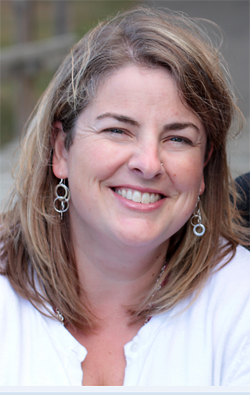
Sheila Kauppi takes over as the Metro District north area manager June 4. Photo courtesy of Frogpad Studios |
The Metro District has selected Sheila Kauppi as the north area manager, effective June 4.
“We’re very excited to have Sheila serve the north area,” said Scott McBride, Metro District engineer. “She has enhanced MnDOT’s relationships with Metro District south area communities and has overseen many projects such as: Hwy 13/Hwy 5, Hwy 169/Hwy 69 and the Hwy 101 Flood Mitigation project.”
Kauppi has been with MnDOT for 15 years. During that time she held positions such as traffic support engineer, assistant preliminary bridge plans engineer, bridge hydraulic design engineer and currently, south area manager.
Kauppi received her Bachelor of Science degree in civil engineering from North Dakota State University.
She can be reached at 651-234-7718 or by email at sheila.kauppi@state.mn.us. |
 |
|

|
 |
TABLE of CONTENTS
 |
Transportation research conference held in St.Paul |
By Nick Busse, Research Services & Library

Linda Taylor, Research Services & Library director; and Mark Nelson, Data Analysis director; answer questions at a session on transportation pooled-fund research projects at the Center for Transportation Studies Research Conference May 21. Photo by Nick Busse |
More frequent extreme weather events and shifting demographic trends will require transportation agencies to innovate and adapt to an increasingly unpredictable future.
That was the keynote message at the 25th annual Center for Transportation Studies Research Conference in St. Paul May 21 and 22.
MnDOT and local transportation officials joined researchers to share lessons learned from a wide range of research projects. They also heard from a pair of experts on how future climate and social changes will likely expose vulnerabilities in transportation systems.
“Transportation officials face growing unpredictability in everything from climate change to driverless vehicle technology to changing preferences in where people live and how much they drive,” said John Njord, a consultant and former Utah DOT executive director. “The reality is, I don't think anybody knows the true answer of what is going to take place. But something is happening ... and it's different from anything that's happened before."
Joe Casola, a scientist with the Center for Climate and Energy Solutions, highlighted the need to make transportation systems more resilient in the face of more frequent heavy rainfalls and extreme temperatures.
Numerous MnDOT research projects were showcased at the conference, including a variety of traffic safety innovations, MnROAD projects, and environmental and economic development initiatives. Presentation slides and materials will be made available on the CTS website in the coming weeks; in the meantime, some photos and highlights have been posted on the Crossroads blog and the MnDOT Research Facebook page.
MnDOT Chief of Staff Eric Davis told conference attendees that closing the state’s transportation funding gap would require more than just raising new revenues — it would require new ways of thinking and doing things.
"Research is vital to our program. It's vital to our success as a department," said Davis. |
 |
|

|
 |
TABLE of CONTENTS
 |
Beth Petrowske receives communications award for Blatnik Bridge event |
By Rich Kemp
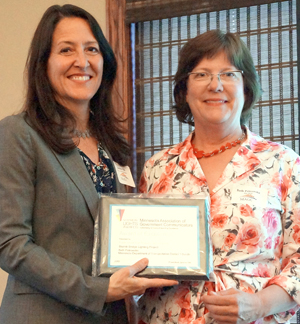
From left: Janine Hill, Minnesota Association of Government Communicators president, presents Beth Petrowske, District 1 public affairs coordinator, with a Northern Lights award at a ceremony May 15 for the Blatnik Bridge Lighting special event. Photo by Yvonne Klinnert, Washington County |
The Minnesota Association of Government Communicators awarded Beth Petrowske, District 1 public affairs coordinator, with a 2014 Northern Lights Award of Excellence for the Blatnik Bridge Lighting special event last fall. The award was presented at a ceremony May 15.
MAGC sponsors the Northern Lights Awards annually to recognize outstanding work in government communications.
Petrowske planned the event to celebrate the completion of the Blatnik Bridge rehabilitation project and the new lighting system. Commissioner Charlie Zelle and Duane Hill, district engineer for District 1, participated in the lighting ceremony.
“The Blatnik Bridge Rehabilitation project affected many peoples’ commutes for two years,” said Hill. “Beth’s public relations program was important in keeping people informed. The Turn on the Lights event was a great finale. Beth worked hard to make the celebration one that people will remember.”
In 2012, the major rehabilitation project began on the bridge. The plan included removal of an obsolete lighting system that followed the contours of the bridge’s arched superstructure. MnDOT and WisDOT partnered on a new, energy-efficient lighting system and shared all costs.
While the bulk of the bridge work focused on improving the structural integrity, months of planning went into the redesign of the new LED lighting system.
The new system has many advantages over the original system including an almost 60 percent energy savings, reduced glare for motorists, along with increased protection from snow and roadway salt spray.
Click here to watch a video of the lighting ceremony. |
 |
|

|
 |
TABLE of CONTENTS
 |
On the Job: Commercial vehicle investigator Mike McKay keeps roads, passengers safe |
By Greg Ruhland, Office of Freight and Commercial Vehicle Operations
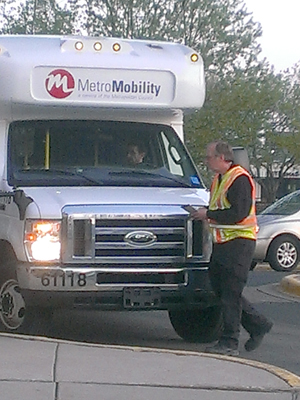
MnDOT inspector Mike McKay looks at a Metro Mobility vehicle, which is a Special Transportation Service, during a May 17 saturation at International Market Square in Minneapolis. Inspections of 28 vehicles resulted in 29 equipment and driver violations. Photo by Greg Ruhland |
Each year, MnDOT’s passenger commercial vehicle investigators perform safety audits of more than 450 limousines and 375 passenger carriers licensed in Minnesota. Working as a team, and sometimes with the Minnesota State Patrol and other law enforcement agencies, they ensure that drivers, companies and vehicles are operating within state and federal safety regulations.
Mike McKay is one of 11 MnDOT investigators of passenger carriers throughout the state. McKay is a transportation program team leader who has more than 45 years in the industry, spanning both public and private sectors.
What types of investigator are there?
Although we focus mainly on inspections at a carrier’s place of business, we do a limited number of inspections annually for certification purposes. Some passenger vehicles are inspected at a point of origin or destination such as a prom, ball game, or other special event.
Sometimes inspections are triggered by a customer or citizen complaint. In that case, we ask the carrier or driver for driving qualification files, hours of service records, maintenance files and drug and alcohol testing program records.
What do you look for during an inspection?
We make sure the driver holds a valid permit, and the permit number is “conspicuously displayed” on the vehicle. If the vehicle is a limousine, it should be operating under the same carrier name as on the permit, display a valid decal on the windshield, have proper insurance and a record of annual inspections.
We also inspect the mechanical components of each vehicle such as the suspension, steering, frame, exhaust and tires to ensure that they are in good working order. Inspection ramps are used to inspect these components on a motor coach. Wheeled creepers are used to complete the inspections performed on limos and buses. We check other safety items, such as a working phone to use in the event of an emergency, fire extinguisher, and emergency reflective triangles.
Any recent findings that stand out?
At a May 17 passenger saturation – an event which allows several vehicle inspections to be performed at once – MnDOT staff performed 28 passenger vehicle inspections at the Mall of America in Bloomington and International Market Square in Minneapolis.
By the end of the night, 29 equipment and driver violations were discovered, and two vehicles and two drivers were placed out-of-service. We were assisted by members of the Minnesota State Patrol, who cited six underage prom-goers for minor alcohol consumption.
Do you ever pull vehicles over?
MnDOT does not pull vehicles over for an inspection, and hasn’t for decades. That’s why our vehicles have yellow lights instead of red lights and sirens.
What do you do when you’re not performing inspections?
We focus on responding to passenger complaints, providing customer support for questions regarding passenger laws and regulations, and providing subject matter expert support for communication and training.
Anything else we should know?
The Office of Freight and Commercial Vehicle Operations keeps ratings of companies that transport people in Minnesota, which tells consumers whether or not that company has adequate safety management practices in place. Companies with qualified drivers and well-maintained vehicles in good working order receive higher ratings. It’s always a good idea to check a company’s safety record before renting a party bus, limousine or motor coach.
Do you or a co-worker have an interesting job to share with readers? Click here to send us your ideas, and we’ll contact you for more information.
Recent employee profiles:
|
 |
|

|
 |
TABLE of CONTENTS
 |
Environmental Stewardship group cleans up Hwy 5 right of way in state park |
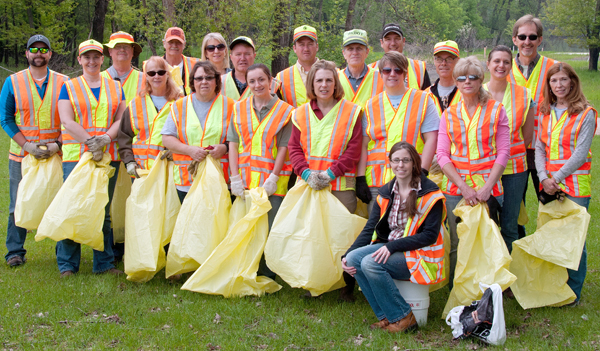
Office of Environmental Stewardship staffers stepped away from their desks May 20 to "walk the talk" of their office's mission, which includes protecting and preserving the quality of Minnesota's environment. The group tackled a section in Fort Snelling State Park, concentrating on the Hwy 5 right of way and detention ponds. Photo by David Larson |
|
 |
|

|
 |
TABLE of CONTENTS
 |
Tools on the Web – project pages |
By Libby Schultz

Example of a project page on the MnDOT website. |
MnDOT project pages have valuable information about current and future construction projects in the Twin Cities and Greater Minnesota.
Each page has information about traffic impacts, a summary of the work, location, benefits and a schedule. Some pages have pictures of ongoing construction, renderings of the final outcome – like the St. Croix Crossing page – and a map of planned detours.
There is also an opportunity to sign up for project email updates through Constant Contact. When there is an update to a project, like a detour or closure, an email is sent to everyone on the project list.
Project pages can be found by selecting a specific highway, project or region on the Current or Future construction pages. |
 |
|
| |
|



